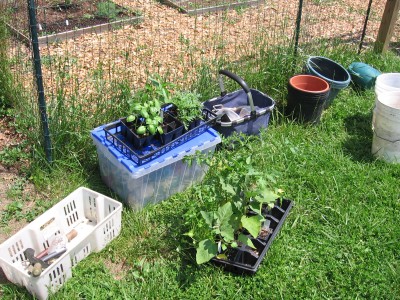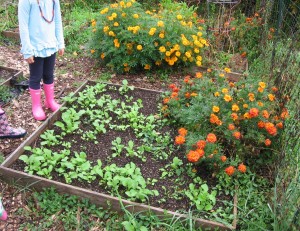 So you have, or want to start, a School Sustainable Vegetable Garden. How do you choose what to plant?
So you have, or want to start, a School Sustainable Vegetable Garden. How do you choose what to plant?
Well, what do you dream of planting? Tomatoes, corn, squash, green beans, and carrots? You and your students will learn from every experiment. But there are some plants that work better than others given the growing seasons, limited adult help, and the restrictions of a typical school year ending in June and beginning in September.
First, think about what your goal is for involving the children. One goal is to directly plant, pick, and eat. In the spring, between the start of warm weather and the end of the school year (Pennsylvania), you can successfully grow lettuce, spinach, radishes, and similar quickly growing, cool weather vegetables. Children are intrigued and engaged in picking and directly tasting lettuce, and excited about finding the biggest radish that can be pulled out of the ground. Wash, slice, and share it within the classroom. If, in addition, you can plant in the spring and harvest in the fall, your options greatly increase (see below).
This spring harvest of quickly growing veggies can also be successful in the fall. If you plant quickly growing cold weather vegetables the first or second week of school, you can comfortably harvest before it gets too cold. With a bit of care (a tarp or bed of straw over the vegetables during a cold snap), you can harvest into November. Water, thin plants, and weed your garden as necessary.
With more adult effort, peas or green beans can reliably be planted by Saint Patty’s Day and harvested before the end of school. This creates two additional challenges: wildlife and tall plant growth. Birds, rabbits, and other animals LOVE to eat these seeds or young plants, so, protect your vegetables by using deer mesh or some other animal barrier. To give height for plants to grow, create a simple stretch of strings, purchase a structure such as a trellis, or plant by a fence.
If you have summertime adult assistance and can plan ahead for the second year, plant in the spring for a fall harvest. With minimal help of one hour a week (watering, harvesting, weeding, etc.), you can grow tomatoes, peppers, eggplants, red beets, Swiss chard, zucchini, and carrots. When you start school in the fall, you may have a bunch of weeds, but hardy plants will survive, and might “surprise” students as they weed.
Some seemingly-ideal plants don’t work well in a school garden. Corn is highly attractive to raccoons and is likely not to survive. Pumpkins need a tremendous amount of space.
Opportunities abound for curricular connections with a garden. Consider teaching “the parts of a plant” by growing different edible parts: lettuces are leaves. Peas are seeds. Radishes are roots. Cherry tomatoes for a fall crop are also excellent to “pick and eat.”
Whatever you decide, start a School Sustainable Vegetable Garden this year. Dream of the garden you want, experiment with the seeds and space that you have, and nurture adult help that supports this excellent educational opportunity for your students.

